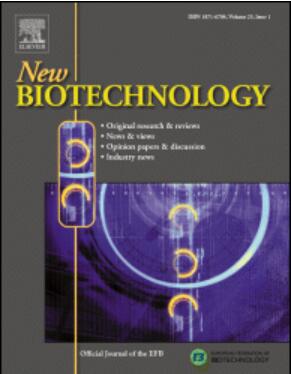Single-cell proteins polyhydroxyalkanoates-rich microbial biomass from municipal and winery waste as potential additive for aquafeeds
IF 4.9
2区 生物学
Q1 BIOCHEMICAL RESEARCH METHODS
引用次数: 0
Abstract
This study evaluated single-cell protein production from PHA-rich mixed microbial cultures obtained from fermentation and subsequent PHA storage, using urban (namely food waste and municipal sewage sludge; FW-MSS) and agricultural waste (namely wine lees; WL) streams as substrates. FW-MSS fermentation achieved stable short-chain fatty acid (SCFA) production and a high CODSCFA/CODSOL ratio of 0.77 ± 0.01, which allowed to select a mixed microbial culture (MMC) with intracellular PHA content of 15.1 wt%, which aligns with fish dietary standards and yielded a MMC biomass with a protein level of 55.1 wt% and a balanced essential amino acid (EAA) profile. In contrast, WL fermentation showed lower SCFA content and stability, yielding a MMC with 45.8 wt% of protein along with a high non-conformance rate (53.65 %), and 7.2 wt% PHA, making the resulting MMC more suited as a supplemental protein source. Distinct microbial communities developed in the two SBRs due to different feedstocks, influencing the abundance of PHA-storing bacteria, with no known fish pathogens detected in either sample. Statistical analysis confirmed FW-MSS’s superior product consistency, supporting its potential as a good quality SCP for aquafeed, especially for rainbow trout, as confirmed by its high essential amino acid index (EAAI).
从城市和酿酒厂废料中提取的富含多羟基烷酸盐的微生物生物量作为水产饲料的潜在添加剂
本研究评估了从发酵和随后的PHA储存中获得的富含PHA的混合微生物培养物的单细胞蛋白质产量,利用城市(即食物垃圾和城市污水污泥;和农业废物(即酒渣;流作为底物。FW-MSS发酵获得了稳定的短链脂肪酸(SCFA)产量和较高的CODSCFA/CODSOL比值(0.77 ± 0.01),从而选择了细胞内PHA含量为15.1 wt%的混合微生物培养物(MMC),这符合鱼类的膳食标准,并产生了蛋白质水平为55.1% wt%和平衡必需氨基酸(EAA)谱的MMC生物量。相比之下,WL发酵显示出较低的SCFA含量和稳定性,产生的MMC蛋白质含量为45.8 wt%,不合格率为53.65 %,PHA含量为7.2 wt%,使所得到的MMC更适合作为补充蛋白质来源。由于不同的原料,在两个sbr中形成了不同的微生物群落,影响了pha储存细菌的丰度,在两个样品中均未检测到已知的鱼类病原体。统计分析证实了FW-MSS具有优异的产品一致性,支持其作为水产饲料,特别是虹鳟鱼的优质SCP的潜力,其必需氨基酸指数(EAAI)高。
本文章由计算机程序翻译,如有差异,请以英文原文为准。
求助全文
约1分钟内获得全文
求助全文
来源期刊

New biotechnology
生物-生化研究方法
CiteScore
11.40
自引率
1.90%
发文量
77
审稿时长
1 months
期刊介绍:
New Biotechnology is the official journal of the European Federation of Biotechnology (EFB) and is published bimonthly. It covers both the science of biotechnology and its surrounding political, business and financial milieu. The journal publishes peer-reviewed basic research papers, authoritative reviews, feature articles and opinions in all areas of biotechnology. It reflects the full diversity of current biotechnology science, particularly those advances in research and practice that open opportunities for exploitation of knowledge, commercially or otherwise, together with news, discussion and comment on broader issues of general interest and concern. The outlook is fully international.
The scope of the journal includes the research, industrial and commercial aspects of biotechnology, in areas such as: Healthcare and Pharmaceuticals; Food and Agriculture; Biofuels; Genetic Engineering and Molecular Biology; Genomics and Synthetic Biology; Nanotechnology; Environment and Biodiversity; Biocatalysis; Bioremediation; Process engineering.
 求助内容:
求助内容: 应助结果提醒方式:
应助结果提醒方式:


